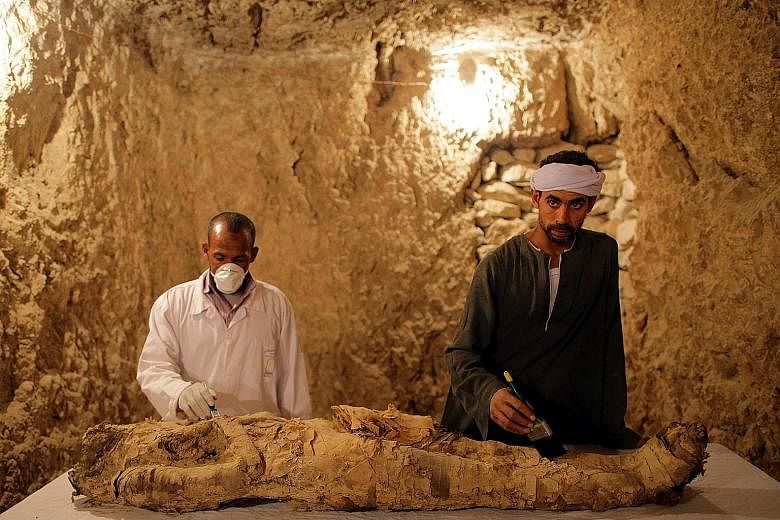LUXOR (Egypt) • Egyptian archaeologists have discovered a mummy in one of two previously unexplored tombs across the Nile from the southern city of Luxor, the antiquities ministry said.
The tombs were found in the 1990s by German archaeologist Frederica Kampp, though she had only reached the entrance gate "but never entered", the ministry said.
It said that both tombs, which were given numbers by Ms Kampp, were likely to date back to dynasties of the New Kingdom, which lasted several centuries until about 3,000 years ago.
Antiquities Minister Khaled al-Enany was in Luxor to announce the discovery in Draa Abul Nagaa necropolis, near the famed Valley of the Kings, where many pharaohs were buried.
In addition to funerary items, archaeologists found "a mummy wrapped in linen", the ministry said, adding that "studies suggest that the mummy could be for a top official or a powerful person".
The owner is unidentified, though the ministry said they have two possible identities.
The tomb might belong to "a person named Djehuty Mes, whose name was engraved on one of the walls", the ministry said.
Or it could belong to "the scribe Maati as his name and the name of his wife, Mehi, were inscribed on 50 funerary cones found in the tomb's rectangular chamber".
The other tomb was not excavated and only "uncovered" in April, the ministry said, adding that its owner is not yet known.
"The tomb has a court lined with stone and mud-brick walls. It has a 6m-deep burial shaft at its southern side that leads to four side chambers," the ministry said.
"Studies reveal that the tomb was reused in antiquity," it said.
The tomb contains several artefacts and a depiction of "a person, probably the deceased's brother, presenting offerings and flowers to the deceased and his wife".
Along with the mummy, archaeologists found painted wooden funeral masks and several hundred carved statues, likely dating around the end of Egypt's 17th Dynasty or the start of the 18th Dynasty, the ministry said.
In September, Egyptian archaeologists announced the discovery of a tomb of a prominent goldsmith who lived more than 3,000 years ago, unearthing statues, mummies and jewellery in the latest major find near Luxor.
AGENCE FRANCE-PRESSE, REUTERS

